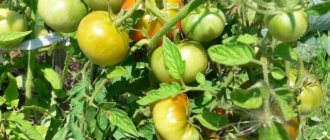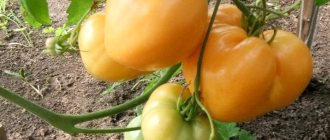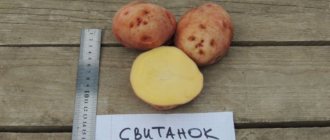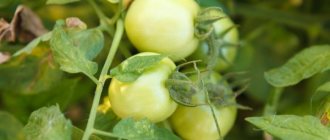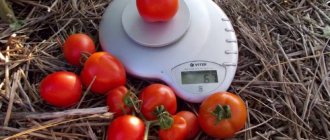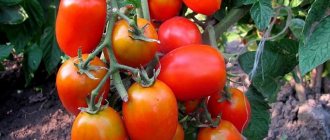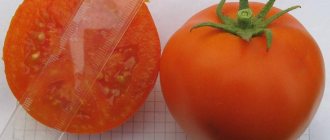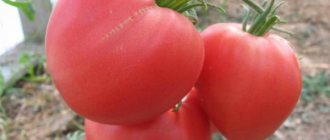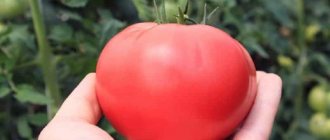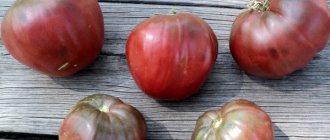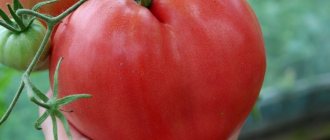In the “hearts” group, this tomato is one of the most beloved by gardeners. The orange heart is distinguished by its delicate, delicious pulp. It has a useful composition - lycopene, carotene, vitamins and minerals. Recommended in baby food, as well as in the diet of allergy sufferers and patients with stomach problems.
| Height | Landing location | Ripening time | Fruit color | Fruit size | Origin | Fruit shape |
| Tall | Greenhouse, Open ground | Mid-season | Orange | Large | Variety | Heart-shaped |
General description of the variety
Tomato Orange Heart is a variety bred by domestic breeders. It is included in the Russian state register and is popular among gardeners all over the world.
This is interesting ! The variety is popularly called Liskin Nos. This is due to the characteristic shape of its fruits, reminiscent of the face of a red animal. This name quickly spread among gardeners, and now it is often found on foreign websites.
Distinctive features of the Orange Heart
The main feature of the Orange Heart variety is the shape and color of the fruit. The berries of this tomato are heart-shaped with an elongated and pointed nose. The color of tomatoes is orange or dark yellow.
The taste of tomatoes is also impressive - sweet, with a pronounced fruity note and barely noticeable sourness. The berries are fleshy and moderately juicy. The composition contains a large amount of sugars.
Another feature is the bushes. Despite the fact that the variety is indeterminate, gardeners note its spreading nature.
Note! Feedback from gardeners is that the fruits in the upper part of the bush are larger and have a more pointed tip than in the lower part of the plant.
Main characteristics
Description of the variety Orange Heart attracts many gardeners. After all, this tomato is not only useful and beautiful, but also undemanding to care.
Characteristics of the Orange Heart tomato:
| Parameter | Indicators |
| Bush type | Indeterminate. It reaches a height of 1.6-2 m. The stems are powerful and durable. The bushes are spreading, with a lot of foliage. The leaves are dark green, medium sized, simple tomato. The first inflorescence is formed in the axil of the 7th or 8th leaf. Subsequent brushes appear every 2 sheets. The fruits are formed in clusters, with each cluster containing from 3 to 6 berries. |
| Growing method | Designed for cultivation in the climatic conditions of our country. Cultivated in greenhouses, film shelters and open ground. |
| Productivity | Average. Up to 4 kg of fruits are collected from one bush during the fruiting period. From one sq. m produces an average of 8 kg of tomatoes. |
| Fruit | Large ones. The weight of one tomato varies from 250 to 400 g. The first fruits are always larger than the next ones. The outside of the fruit is bright orange or dark yellow. The pulp is orange, without light and green spots. The fruits are fleshy, not watery. Some gardeners note that they are not juicy enough. The berries are heart-shaped, with a strongly pointed tip. There is pronounced ribbing at the base, which makes the tomatoes even more heart-like. There are many chambers in the fruits, but there are few seeds in them. |
| Transportability | Low. Due to their thin skin, tomatoes are not suitable for long-distance transportation. These tomatoes don't last long. They have a tendency to crack. |
| Ripening time | Mid-season variety. The first harvest is harvested after 100-110 days. |
| Disease resistance | It is resistant to most tomato diseases. Not resistant to late blight. |
Description of the Orange Elephant tomato
The Orange Elephant tomato variety was bred for growing under film cover, through seedlings, in regions with unstable weather. In southern cities, it can be planted in open beds.
The variety is determinate, medium-growing and mid-ripening. The bush reaches a height of up to 1 m. The fruits begin to ripen 110 days after seed germination. Fruiting is long and abundant.
A powerful bush covered with small dark olive leaves. The first flower ovary appears under the 4-5 leaf.
Description of fruits
The Orange Elephant tomato variety has large fruits, bright orange in color, weighing 300-400 g. The tomatoes are flat-round, uneven in shape, somewhat similar to the head of an elephant.
The low-seeded pulp is dense, fleshy and very aromatic, contains a large amount of vitamin A and C. Thanks to its bright color and sweet taste, children really like the variety. The peel is thin but dense, so the crop is well stored and transported.
Growing seedlings
Tomatoes are cultivated by seedlings. Orange Heart seeds are sown in late February or early March. In the northern regions, seedlings begin to be grown later - at the end of March.
Gardeners recommend familiarizing yourself with the lunar calendar to select the optimal timing for growing seedlings. When growing seedlings using the Chinese method, you need to wait for the waning moon in the constellation Scorpio.
Preparation of planting material
Before use, the seeds must be prepared. This will reduce the likelihood of infection and speed up germination.
Planting material purchased in a store is usually already pickled. This is evidenced by the signs on the packaging and the green or orange color of the seeds.
If there are no signs indicating that the seeds have been disinfected or the planting material was taken from last year’s harvest, the procedure must be carried out independently. To do this, the seeds are immersed for half an hour in a weak solution of potassium permanganate, after which they are washed.
To speed up germination, seeds are treated with a growth stimulant: “Epin”, a solution of honey, soda or aloe, “Fitosporin”.
Selection of containers and soil
Often, tomato seeds are sown in one large, shallow container. Sprouted plants are planted in pots with a volume of at least 300 ml.
Containers for seedlings are disinfected - soaked in a strong solution of potassium permanganate for half an hour or poured with boiling water.
Soil mixture for tomatoes is sold in a specialty store. The soil is also prepared independently. To do this, mix peat, black soil and humus in equal quantities. Ash and sand are added to the composition.
The soil for seedlings is also disinfected - watered with boiling water, a solution of potassium permanganate, or calcined in the oven.
Advice . To reduce the likelihood of seedlings being damaged by blackleg, drainage is poured into the bottom of the picking pots. Its role can be broken brick, expanded clay or ceramics.
Sowing seeds
The Orange Heart planting material is buried 1-1.5 cm. A distance of at least 2 cm must be maintained between the seeds.
After sowing the seeds, moisten the soil with warm water from a spray bottle. The seedlings are covered with film and placed in a warm place. The warmer the room, the faster the first shoots will appear. Light is not necessary for ungerminated seeds.
Seedling care
Proper care of seedlings will allow you to grow healthy and strong plants. How to grow seedlings:
- Before the seeds germinate, the containers are covered with film. This will provide high humidity and the necessary microclimate for their germination.
- After the first shoots appear, the container with seedlings is placed in a well-lit place. To prevent plants from stretching out, gardeners recommend using fluorescent lamps.
- A week after seed germination, the film is removed. Until then, the seedlings still need extreme humidity.
- For irrigation, use only settled water at room temperature. Water the tomatoes so that water does not get on the greens.
- Plants dive when the first true leaves appear on them. There is no need to pinch the root during the transplantation process.
- The plants are watered for the first time after picking a week later. After another week, the seedlings are fed.
- During the entire period of growing seedlings, they are fed three times. Use complex fertilizers or vermicompost. 3 days before planting in a permanent place, tomatoes are fed with fertilizers containing potassium and phosphorus.
- Before planting in a permanent place, tomatoes are hardened off. To do this, plants begin to be taken outside two weeks before picking, gradually increasing the time they stay there.
Agricultural technology of tomatoes Orange heart
Orange heart is grown in open and protected ground. In cold regions, option 2 is preferable.
Tomatoes are planted when the soil warms up. March is considered the optimal time for picking. In the southern regions, planting is possible at the end of April, and in the northern regions - at the beginning of June.
Before picking, tomatoes need to be prepared. To do this, 3 days before the procedure, the plants are watered and fed.
Landing rules
The beds for tomatoes are prepared in advance. In the fall, the soil is dug up and cleared of weeds, after which it is enriched with mullein, ash and lime. In the spring, the soil is dug up again and watered with a solution of copper sulfate.
For tomatoes, dig holes in rows. For 1 sq. m place 2-3 plants. 1 tablespoon of ash is poured into each cavity.
The seedlings are carefully removed from the pots. It is placed in the holes in the center. The depressions are filled with water and covered with soil. The next watering after planting the seedlings is possible no earlier than 2 weeks later.
How to care for a tomato
Bushes of the Orange Heart variety need a garter. The support chosen is strong and high. This can be a wooden peg or trellis.
The plant is formed into 2 or 3 stems. The more stems, the slower the harvest will ripen and the smaller the fruits will be.
Regularly remove the lower leaves and excess tomato shoots. This procedure is carried out in the morning or evening on clear days.
The soil is moistened as it dries. It is important to consider that in dry weather or high humidity, the fruits crack.
Fertilize tomatoes 3-4 times per season. Gardeners recommend alternating mineral complex fertilizers and manure. Foliar feeding with boron will help the ovaries form faster.
Attention . Loosening the beds is mandatory. This procedure destroys the crust and improves air exchange in the roots. Loosening is done after each watering and rain.
The nuances of growing tomatoes Orange Heart
Orange heart is an unpretentious variety. It is undemanding when it comes to fertilizing, and by following the basic rules, even novice gardeners can successfully grow it.
Most tomatoes require three to four feedings per season, but Orange Heart needs two. It is better to use complex fertilizers.
When pinching, it is important to remove the entire body of the shoot. If the shoot is not completely removed, the likelihood of the plant becoming infected will greatly increase.
Diseases and harmful insects
Tomato Orange Heart is immune to viral and fungal diseases. However, it is affected by late blight.
To avoid tomato diseases, follow the rules for caring for them. Do not over-moisten or over-dry the soil. Such conditions are ideal for the development of pathogens.
It is necessary to disinfect not only the soil and planting material. All garden tools that will interact with tomatoes must undergo a disinfection procedure. They may contain fungi and viruses.
To prevent late blight, plants are sprayed with copper preparations. Another method is spraying with a solution of potassium permanganate.
It is important to protect plants from harmful insects. They not only spoil the bushes themselves, but also infect them with fungi and viruses.
Thrips, whiteflies and spider mites are afraid of celandine infusion. Slugs are repelled by a solution of ammonia. To get rid of aphids, use a soap solution. The above-ground parts of the plant are sprayed with this product.
Characteristics of tomato
This tomato variety has a very good set of characteristics. We can say that it is one of the most successful hybrids created over the past 20 years. The combination of excellent taste properties of fruits and average ripening times are very attractive to many gardeners.
Productivity and fruiting
If agricultural practices are followed correctly, the Orange Heart tomato can produce abundant harvests. In open ground, the yield is up to 2 kg per bush, when grown in greenhouses - more than 4 kg per bush. Planting both in open ground and in greenhouses is recommended in 2 rows with a distance between plants of 50 cm, and between rows of 40 cm. At the same time, given the high foliage of the plant and the large size of the bushes, it is not recommended to plant more than 2-3 plants per 1 sq. . m. Thus, the yield, depending on the method of cultivation and planting density, can range from 4 to 12 kg per square meter. m area.
These are ideal indicators; in reality, the results are a little more modest. According to reviews from gardeners, the yield of Orange Heart tomatoes is about 8-10 kg per 1 sq. m area; The typical appearance and size of the fruit is shown in the photo below.
The ripening time in the greenhouse is about 3 months. Officially, the time is 90-95 days, however, technical ripeness occurs approximately a week and a half before complete ripeness. In open ground they are extended for another 1 month (from 120 to 135 days).
The main factor affecting yield is the way the plant is grown. When using single-stem agricultural technology, the yield will be low: it is unlikely that you will be able to remove more than 2 kg from a bush during greenhouse cultivation. Growing an Orange Heart tomato with 3 stems is quite problematic technically, given the high density of the bush.
Therefore, double-stem cultivation is used. It is this that allows you to maintain a balance in the number of bushes per unit area and ensure maximum yield per 1 square meter. m.
Area of application of fruits
The fruits of the Orange Heart tomato variety are used mainly fresh. They are used to prepare first and second courses, in particular, hot and cold soups, side dishes, and sauces. In salads, thanks to its excellent taste, this variety has virtually no equal. Tomatoes have proven themselves very well in making juice.
Due to the absence of red coloring pigment, which is a strong allergen, orange tomatoes are considered an almost hypoallergenic product and are recommended for baby food.
Due to its dense structure and fairly durable skin, the fruits of this tomato variety have good keeping quality and transportability.
However, this variety is practically not suitable for preservation. Prolonged heat treatment and stay in the marinade significantly worsen the consistency of the pulp and its taste: it becomes fibrous and sour.
Resistance to diseases and pests
The Orange Heart tomato is highly resistant to the following diseases:
However, we should not forget about preventive measures that have approximately the same sequence of actions for most tomato diseases.
It should also be noted that the Orange Heart tomato has relatively good resistance to aphids and mites.
Advantages and disadvantages of the variety
Summarizing the description and characteristics of the Orange Heart tomato variety, we can say that it has the following advantages:
- excellent taste;
- increased content of useful elements in the pulp;
- absence of allergens;
- high productivity;
- unpretentiousness in cultivation - the variety is recommended for cultivation in a wide variety of climatic conditions;
- good resistance to major tomato diseases and pests;
- high shelf life and transportability.
The disadvantages of the variety are:
- relative difficulty in forming a bush due to active pinching;
- the impossibility of obtaining your own seed, since the variety is actually a hybrid.
Tomatoes obtained from such plants will be small, tasteless and have a wide variety of colors and shapes.
Features of growing in protected and open ground
When growing Orange Heart tomatoes in open ground, it is important to protect the plants from frost for the first two weeks after transplantation. To do this, they are covered with film at night. The same technique is used on cool days.
It is necessary to mulch the beds of tomatoes grown in open ground. This will protect the plants from frost, soil drying out, pests and parasites.
Greenhouses with tomatoes are ventilated daily by opening the windows in the room.
Harvesting and application
The first Orange Heart fruits ripen in July. Tomato berries become bright orange and soft.
On cloudy days or during an epidemic, late blight picks off large unripe fruits. In this case, be sure to leave the stalk. Then the tomatoes will ripen quickly indoors.
Orange Heart tomatoes are intended for fresh consumption. It is possible to prepare sauces and juices from the fruits. In general, they are not preserved due to the fact that they crack and soften.
Advice . Gardeners recommend not throwing away the pulp left over from preparing tomato juice. This raw material is used as fertilizer for tomato and other crops.
Pests and diseases
Despite the fact that Orange Heart has a high resistance to diseases and pest attacks, preventive measures must be taken. Most often, plants are attacked by the following insects:
Spider mite
To prevent the appearance of this insect, it is necessary to follow the planting pattern, loosen the soil more often and destroy weeds. If the mite appears on plants, use Actellik, Flumite, Fitoverm.
Aphid
If aphids are present, plants are treated with preparations such as Karbofos, Actellik, Biotlin. If you do not fight this pest, the bushes may die, as aphids feed on plant juices, thereby drying out and destroying them.
For preventive purposes in the fight against fungal diseases, plants are treated with Bordeaux mixture.
Svetlana
Our family loves Orange Heart. We have been growing this type of tomato on our plot for a long time. I really like the taste of the fruit. They are juicy, sweet, meaty. Tomatoes are ideal for fresh salads. I also preserve this variety for the winter. Fresh tomatoes can be stored for a long time. We eat them almost until mid-November.
Kira
My children really love this variety of tomatoes. They grow bright orange. The fruits themselves are sweet and very tasty. When the first fruits appear, my children cannot wait for them to ripen. They eat them fresh with pleasure.
The tomatoes are very tasty. They have juicy and fleshy flesh. There are practically no seeds inside. If you properly care for the Orange Heart, whole bunches of fruits ripen on one bush. The harvest is always simply magnificent. It is stored almost until the end of autumn. That’s why we have fresh and delicious tomatoes on the table for a very long time.
Farmer reviews
Reviews about the Orange Heart tomato are positive. Gardeners note the excellent characteristics of these tomatoes.
Ilya Sadovnik, Klin: “I was given Orange Heart tomato seeds last year. I grew them in a greenhouse. The stems grew tall and powerful. The first fruits had a very pointed shape and resembled a heart. The next tomatoes were more round. Closer to autumn, the plants became infected with late blight.”
Alina Kryukova, Sochi: “ I have been growing Liskin Nos (Orange Heart) tomatoes for the second year now. I like the beautiful sweet fruits that are great for salads. I didn’t notice any particular difficulties in growing. The largest tomato of this variety weighed 378 g.”
Diseases and pests
Tomatoes "Oxheart pink" are immune to late blight. But they are not immune from other diseases. High humidity causes fungal rot:
- Gray rot. Brown spots form on the leaves and stems, which are covered with a gray fluffy coating. All infected areas are cut off and only healthy ones are left. The bushes are treated using systemic fungicides (Ordan, Fundazol, Previkur) or copper preparations;
- Brown spot. Yellow spots of various sizes appear on the leaves, gradually growing, which leads to the falling of the leaves. Then the flowers and fruits dry out. As a preventive measure, seed material is treated with the preparation “Bravo”, and infected bushes are treated with copper preparations.
Tomato Bull's Heart - variety description:
Pests:
- The most important pest for tomatoes is aphids. To get rid of it, all plantings are treated with insecticides such as “Confidora”, “Akarina”, “Decisa”;
- Cotton and tomato bollworms. Adults do not cause any harm to plantings. Tomato leaves are intensively eaten by their caterpillars. “Aktofit”, “Zolon”, “Decis”, “Profi” help to fight them.
